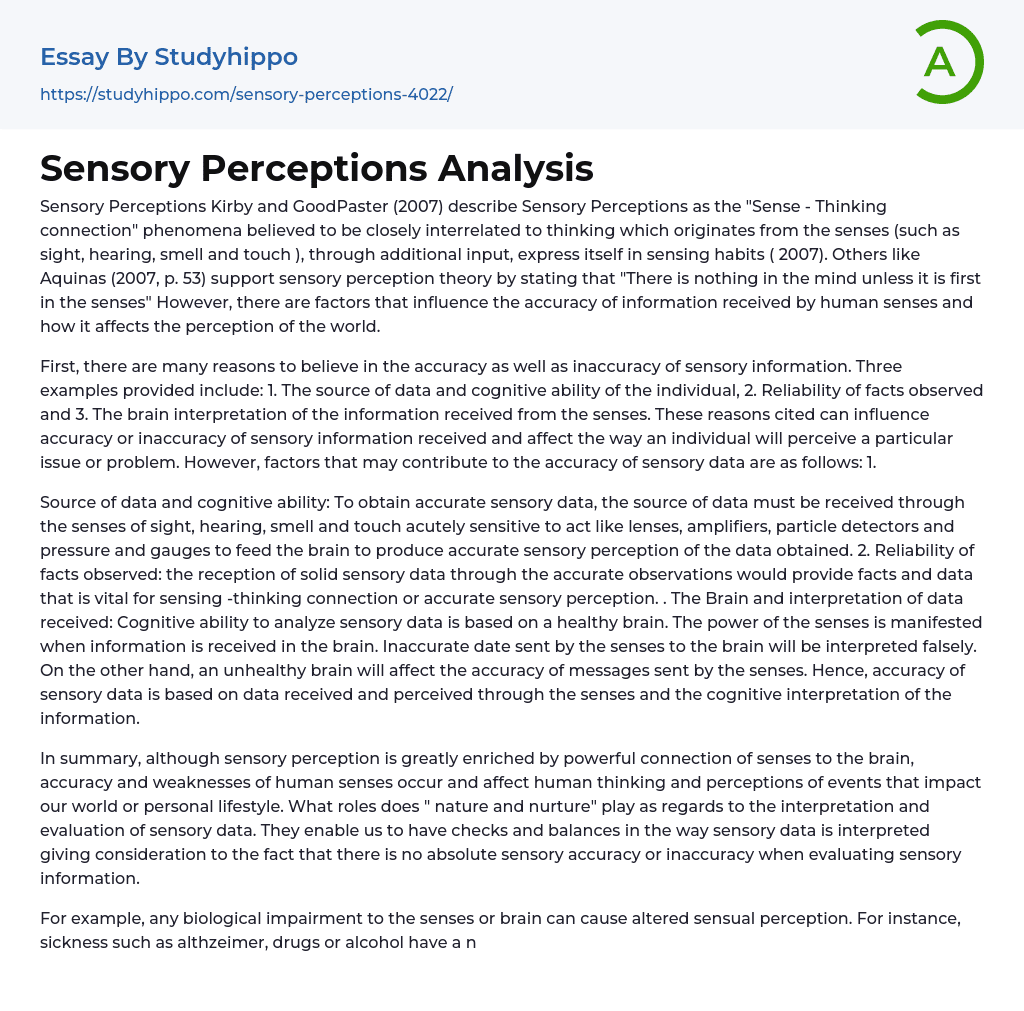Kirby and GoodPaster (2007) define sensory perceptions as the connection between the senses and thinking. These perceptions originate from sight, hearing, smell, and touch and are conveyed through sensing habits with supplementary input (Kirby and GoodPaster, 2007). Aquinas (2007, p. 53) supports this notion by claiming that nothing can exist in the mind without being perceived by the senses. However, various factors affect the precision of human reception of sensory information and its impact on our perception of reality.
Several factors influence the precision or imprecision of sensory information. These factors include the origin of data, individual cognitive capacity, credibility of observed facts, and the brain's interpretation of sensory input. These components shape an individual's perception of a particular issue or problem. Moreover, specific elements contribute to the accuracy of sensory data.
The accuracy of
...sensory data relies on the source and cognitive ability. The senses - sight, hearing, smell, and touch - serve as lenses, amplifiers, particle detectors, and pressure gauges for precise perception. It is crucial to receive reliable sensory data for accurate observations and acquiring essential information. Analyzing sensory data depends on a healthy brain; an unhealthy one affects the interpretation of messages from the senses. Thus, both the data received through the senses and its cognitive interpretation by the brain determine the accuracy of sensory information.
To summarize, the connection between our senses and the brain greatly enhances sensory perception. However, there are limitations and weaknesses in human senses that can affect our thinking and perception of events that impact our lives. "Nature and nurture" play a role in how we interpret and evaluate sensory data, allowing for checks and balances to consider th
lack of absolute accuracy or inaccuracy in sensory information.
For example, biological impairments to the senses or brain can lead to altered sensual perception. Sickness such as Alzheimer's or the use of drugs or alcohol can negatively impact the interpretation and evaluation of sensory data, providing deceptive information to the brain, ultimately leading to false interpretation (Kirby/Goodpaster, 2007). Nature and nurture also play a role in altering human sensory perception and thinking through customs, personal habits, and biases that influence the interpretation and evaluation of sensory data.
Many people have different perspectives and views based on their sensory perception when observing an object or event. This does not mean that these perspectives are deceptive or false, but rather highlights the complexity of human perception. Even perceived inaccuracies can lead to creative thinking and the generation of unique information. Recognizing personal biases and habits that can distort sensory perception allows individuals to utilize scientific instruments, such as electronic microscopes, ultrasounds, magnetic resonance, and radar telescopes, to enhance the reception of sensory data and provide objective interpretations. These instruments play a crucial role in both science and the arts by ensuring the acquisition of accurate information and minimizing deception or inaccuracies in sensory data interpretation. In conclusion, acknowledging the weaknesses in sensory perception caused by various factors such as personal attitudes, customs, and environment, and having an open mind to learn helps sharpen sensory perceptions.
- Common sense essays
- John Locke essays
- 9/11 essays
- A Good Teacher essays
- A Healthy Diet essays
- A Modest Proposal essays
- A&P essays
- Academic Achievement essays
- Achievement essays
- Achieving goals essays
- Admission essays
- Advantages And Disadvantages Of Internet essays
- Alcoholic drinks essays
- Ammonia essays
- Analytical essays
- Ancient Olympic Games essays
- APA essays
- Arabian Peninsula essays
- Argument essays
- Argumentative essays
- Art essays
- Atlantic Ocean essays
- Auto-ethnography essays
- Autobiography essays
- Ballad essays
- Batman essays
- Binge Eating essays
- Black Power Movement essays
- Blogger essays
- Body Mass Index essays
- Book I Want a Wife essays
- Boycott essays
- Breastfeeding essays
- Bulimia Nervosa essays
- Business essays
- Business Process essays
- Canterbury essays
- Carbonate essays
- Catalina de Erauso essays
- Cause and Effect essays
- Cesar Chavez essays
- Character Analysis essays
- Chemical Compound essays
- Chemical Element essays
- Chemical Substance essays
- Cherokee essays
- Cherry essays
- Childhood Obesity essays
- Chlorine essays
- Classification essays




